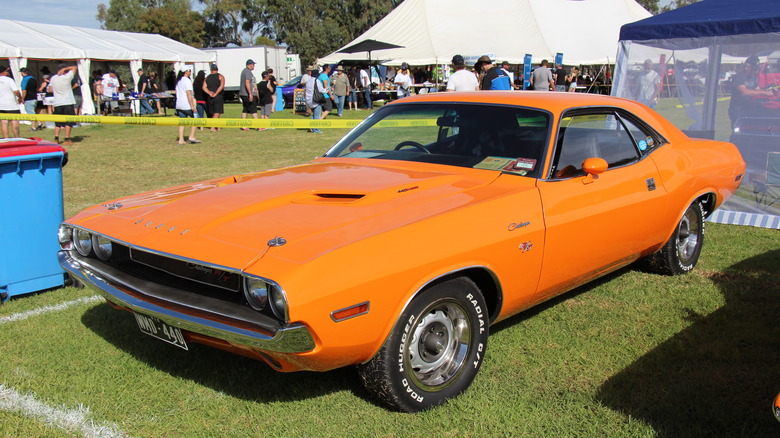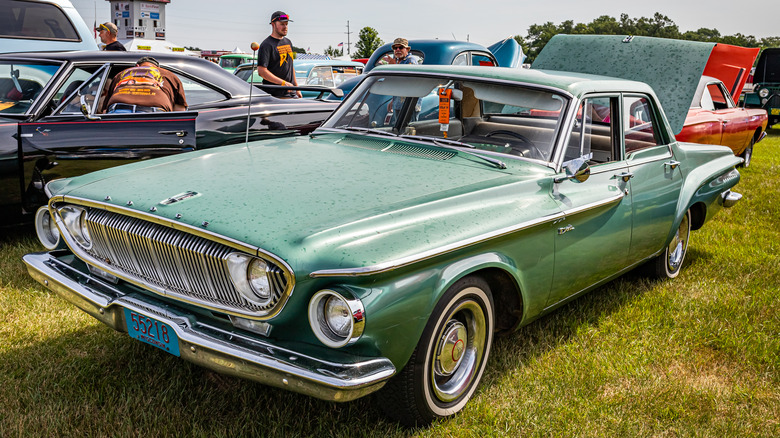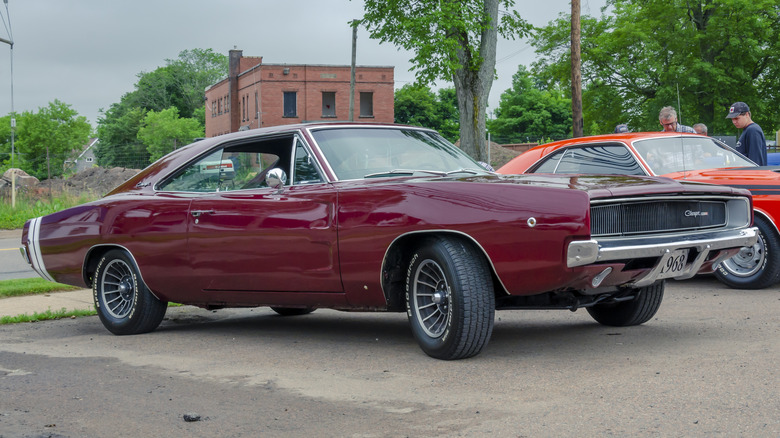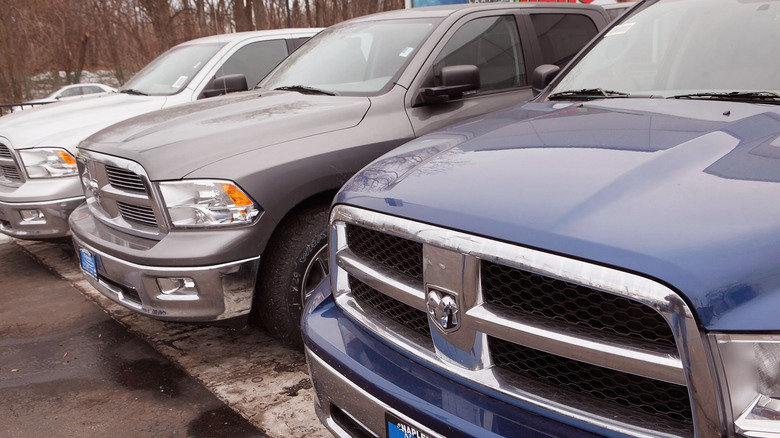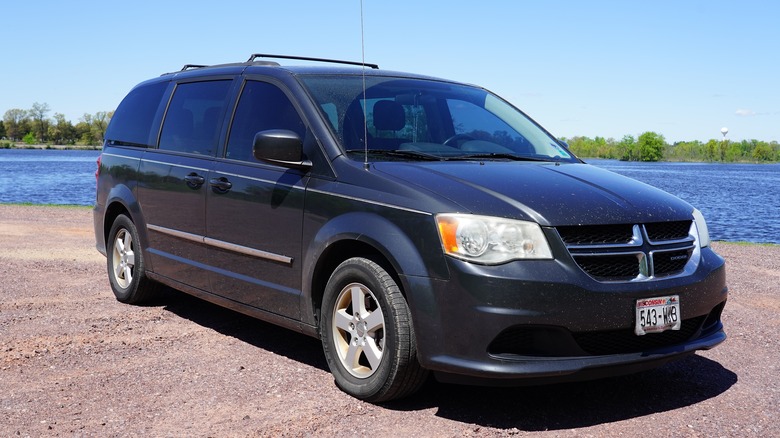4 Of The Most Successful Dodge Models Ever Sold In The US
Brothers John and Horace Dodge began making bicycle parts before moving on to building engines, transmissions, and axles for the likes of Oldsmobile, Northern, and Ford. They built the first Dodge car in November of 1914, and by the next year, Dodge was the nation's third-largest automaker. John and Horace died in 1920, and eight years later, Walter Chrysler bought the Dodge corporation for $170 million. Ram split off into its own brand in 2009, and both Dodge and Ram are now part of Stellantis, which formed when FCA and PSA joined forces in 2020.
Dodge has made many successful models throughout the decades, and the brand thrived during the muscle car era of the 1960s and early '70s. In 1981, it introduced the Ram pickup, and has since climbed the ladder to become the second best selling truck brand in the U.S. as of this writing. One of Dodge's top models in 2023 was the Durango SUV, which saw sales of nearly 70,000 units. However, Dodge's list of best-selling vehicles of all time includes vehicles of all types. Here are a few of its most popular.
[Featured image by Sicnag via Wikimedia Commons | Cropped and scaled | CC-BY 2.0]
The original Dart was produced in massive numbers
Dodge introduced the Dart as a full-sized model in 1959 and moved the nameplate to an intermediate-sized body for the 1963 model year. Early Darts were powered by the 170- and 225-cubic-inch versions of Chrysler's venerable slant-6 engine, and in 1964, the firewall was reconfigured to make room for a 273-cubic-inch V8. After a couple of major redesigns in 1967 and 1970, Dodge added the Demon to the Dart stable in 1971. This high-performance fastback was fashioned after the Plymouth Valiant Duster and came with one of three engines: a 225-inch slant six, a 318-cubic-inch V8, or a 340-inch V8.
The Demon was — for some reason — originally supposed to be called the "beaver," but the brand wisely decided against that. Still, in 1973, pressure from Christian groups displeased with the Demon name and devilish logo forced Dodge to rename it the Sport. The original Dart stayed in production through 1976 when Dodge shelved the nameplate for more than 30 years.
In 2012, Dodge brought the Dart name back, but in a model that only lasted until 2016 due to underwhelming sales. In contrast, the earlier version was produced in large numbers for most of its run. In 1960 and 1961, Dodge made nearly a million Darts. Then in 1963 alone, production approached 450,000 units. Altogether, Dodge produced almost a million Darts between then and 1976, bringing the original Dart's run to somewhere in the ballpark of 2.5 million cars.
The Challenger also had a long but interrupted run
The Charger is another Dodge that has lived separate lives as a classic and modern model. It debuted on the B-body platform in 1966, and was one of the Mopar models that got the legendary 426-cubic-inch Hemi engine. The Charger was updated in 1968, and the next year, the 225-cubic-inch slant six was added to the list of available Charger engines. Two of the more powerful Charger models from this generation were the R/T 440, which made a memorable appearance during the chase scene in the 1968 movie "Bullitt," and the Daytona, a submodel designation that returned in 2024 as an electric muscle car.
The original Charger stayed on the B-body platform through 1978, then returned as a subcompact hatchback in 1982 with an array of wimpy inline four-cylinder powerplants. That disappointing model sullied the Charger's proud nameplate, which went on hiatus after the 1987 model year.
The Charger returned in 2006, with a 250-horsepower V6 and a couple of hemi V8s powering the resurrected version. More recently, Dodge gave the Charger an even bigger boost with the Hellcat Redeye submodel, powered by a supercharged 6.2-liter hemi V8 that makes close to 800 horsepower. Good Car Bad Car counts U.S.-based Charger sales at just over 1.6 million units since the model's 21st Century revival, with the apex coming in 2007 at close to 120,000 sold.
The Ram pickup is the third-most popular truck in the U.S.
Pickup trucks are undeniably popular in the United States, with the Ford F series outselling all other vehicles in its domestic market for more than 40 straight years. Motor 1 counted the Ram series as America's third-favorite pickup in 2023 behind the F series and the Chevrolet Silverado, but the Ram's sales of 444,926 units actually marked a decline of roughly 22,000 trucks from the year before.
Dodge has sold at least 175,000 Ram trucks every year since 2005, with a peak in 2019 of just under 634,000 units. Dodge and Ram dealers sent more than 8.6 million Ram trucks home with buyers in that span. Dodge plans to launch the battery electric 2025 Ram 1500 REV by the end of this year, which should provide about 350 miles of range with a 168 kilowatt-hour battery pack. If Dodge holds true to this promise, adding an electric Ram to the lineup could further boost sales of what is already one of the most popular pickup trucks.
The Grand Caravan has been a steady seller since its debut
The last Dodge on this list might surprise those of you anticipating the inclusion of another high-performance muscle car, but the enduring popularity of Dodge's pioneering minivan means it must be included here. The Caravan hit the market in 1984 and was joined by the Grand Caravan three years later. The Grand Caravan had a longer wheelbase to allow for more cargo room, and it stayed popular through 2020, when the Grand Caravan was discontinued amid the nation's obsession with SUVs. Stellantis kept the nameplate in circulation, though, moving it to a Chrysler minivan that will be sold in Canada.
The Caravan and Grand Caravan were strong sellers over their long run, with Dodge moving 14.6 million of the minivans through 2019. These two models may seem anachronistic in an era where crossovers and SUVs dominate the roads, but the Caravan was innovative when it was introduced and actually helped Chrysler stay alive at a time when the Lee Iacocca-led company was foundering.
Chrysler spent almost half of its $1.5 billion federal bailout loan developing the Caravan and Plymouth Voyager, aiming to build a line of vehicles that were roomy enough for a family and its gear, yet were also easy to load and unload and could be parked in a standard garage. By meeting those modest goals, Chrysler managed to redefine how families traveled for more than 30 years.
